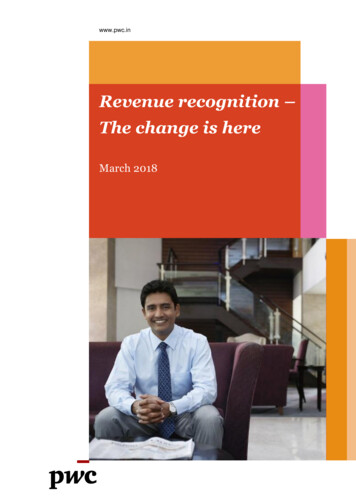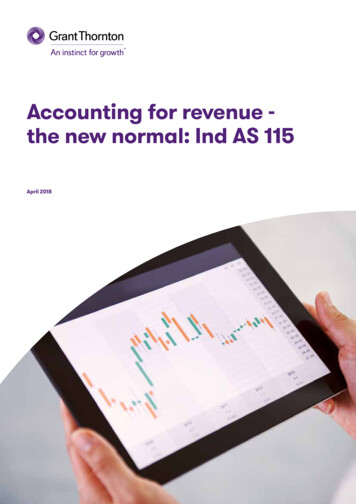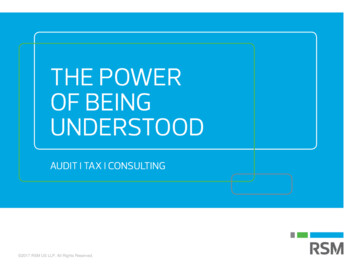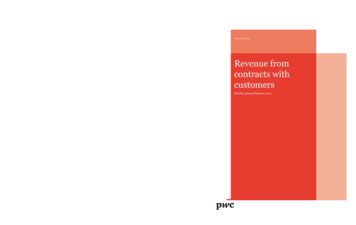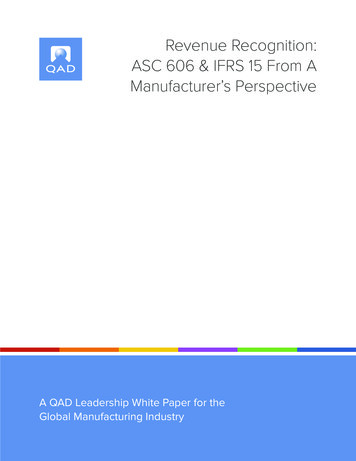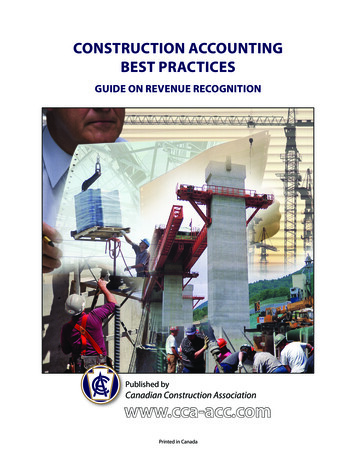
Transcription
CONSTRUCTION ACCOUNTINGBEST PRACTICESGUIDE ON REVENUE RECOGNITIONPublished byCanadian Construction Associationwww.cca-acc.comPrinted in Canada
TABLE OF CONTENTS1.0Purpose of Guide .2.0The Value of Financial Statements .3.0. . . . . . . . . . . . . . . . . . . . . . . . . . . . . . . . . . . . . . . . . . . . . . . . . . . . . . . . . . . . . . . . . . . . . .1. . . . . . . . . . . . . . . . . . . . . . . . . . . . . . . . . . . . . . . . . . . . . . . . . . . . . . .22.1Accounting Principles and Reporting Standards2.2Financial Statements and Their Users .2.3Audit, Review and Compilation EngagementsRevenue Recognition . . . . . . . . . . . . . . . . . . . . . . . . . . . . . . . . . . . . .2. . . . . . . . . . . . . . . . . . . . . . . . . . . . . . . . . . . . . . . . . . . . . .2. . . . . . . . . . . . . . . . . . . . . . . . . . . . . . . . . . . . . . .5. . . . . . . . . . . . . . . . . . . . . . . . . . . . . . . . . . . . . . . . . . . . . . . . . . . . . . . . . . . . . . . . . .63.1Completed Contract Method. . . . . . . . . . . . . . . . . . . . . . . . . . . . . . . . . . . . . . . . . . . . . . . . . . . . . .63.2Percentage of Completion Method . . . . . . . . . . . . . . . . . . . . . . . . . . . . . . . . . . . . . . . . . . . . . . . .84.0Lines of Credit, Bank Loans and Long Term Debt5.0Differential Reporting.6.0Future Income Taxes .7.0GST/HST and the Construction Industry. . . . . . . . . . . . . . . . . . . . . . . . . . . . . . . . . . . . . . . . . . .9. . . . . . . . . . . . . . . . . . . . . . . . . . . . . . . . . . . . . . . . . . . . . . . . . . . . . . . . . . . . . . . .10. . . . . . . . . . . . . . . . . . . . . . . . . . . . . . . . . . . . . . . . . . . . . . . . . . . . . . . . . . . . . . . . .11. . . . . . . . . . . . . . . . . . . . . . . . . . . . . . . . . . . . . . . . . . . . . . . .12. . . . . . . . . . . . . . . . . . . . . . . . . . . . . . . . . . . . . . . . . . . . . . . . . . . . . . . . . . .127.1General Timing Rules7.2Special Timing Rules for Certified Progress Payments .7.3. . . . . . . . . . . . . . . . . . . . . . . . . . . . . .12Completed Construction Contracts . . . . . . . . . . . . . . . . . . . . . . . . . . . . . . . . . . . . . . . . . . . . . .137.4Special Timing Rules for Holdbacks . . . . . . . . . . . . . . . . . . . . . . . . . . . . . . . . . . . . . . . . . . . . . .137.5Builder Lien Holdbacks. . . . . . . . . . . . . . . . . . . . . . . . . . . . . . . . . . . . . . . . . . . . . . . . . . . . . . . . .138.0Financial Instruments . . . . . . . . . . . . . . . . . . . . . . . . . . . . . . . . . . . . . . . . . . . . . . . . . . . . . . . . . . . . . . . . . . . . . . . . 139.0AppendicesA-1. . . . . . . . . . . . . . . . . . . . . . . . . . . . . . . . . . . . . . . . . . . . . . . . . . . . . . . . . . . . . . . . . . . . . . . . .XYZ Construction, Balance Sheet and Income Statement Comparison,Percentage of Completion and Completed Contract Methods . . . . . . . .A-1-1 XYZ Construction Sample Data, Percentage of Completionversus Completed Contract Methods . . . . . . . . . . . . . . . . . . . . . . . . . . . . . . . . . .15. . . . . . . . . . . . . . . . . . . . . . . . .17A-1-2 XYZ Construction Sample Journal Entries, Percentage of Completionversus Completed Contract Methods . . . . . . . . . . . . . . . . . . . . . . . . . . . . .A-215. . . . . . . . . . . . . . . .XYZConstruction Balance Sheet and Income Statement Comparison,Percentage of Completion Method Using Billings Basis versus Cost Basis .A-2-1 XYZ Construction Sample Data, Percentage of Completion Method,Billings Basis versus Cost Basis . . . . . . . . . . . . . . . . . . . . . . . . . . . . . . . . . .18. . . . . . . . . . . . .20. . . . . . . . . . . . . . . . .21
1.0 PURPOSE OF GUIDEThe primary purpose of this guide is to identify and promote a better understanding of the accountingprinciples relevant to the construction industry, in the areas of revenue recognition, future income taxesand debt financing. It also discusses differential reporting options available to private companies. Thisguide will provide guidance on when to use the percentage of completion and the completed contractmethods of revenue recognition, and demonstrate the effect these methods have on a company’sbottom line.For the percentage of completion method, the guide will also discuss the use of billings as the basisfor determining the extent of work accomplished versus using costs (or other rational bases) in thatdetermination. It will demonstrate the effect that these bases will have on a company’s bottom line,including the income tax effect.The guide addresses current and future income taxes as they relate to holdbacks on constructioncontracts and other temporary differences resulting from amortizing assets for book purposes atdifferent rates than the capital cost allowance rates stipulated by the Canada Revenue Agency (“CRA”).It provides guidance on the special GST/HST rules that apply to the construction industry.The guide will introduce contractors to the new accounting rules surrounding “financial instruments”which will become mandatory for private companies in the first fiscal year beginning on or after October1, 2007. Due to the complexity of the new rules and their application, contractors will need to consultwith their professional accountants to decide on the alternatives that will best serve the needs of theirfinancial statement users.This guide is written primarily with a view to help contractors understand that their decision onrecognizing revenue using one of the two methods discussed in this paper, may impact upon theinformational needs of banks in determining debt capacity and covenants for companies in theconstruction industry and for credit rating agencies. It is also relevant to the needs of a surety companyin determining the bonding capacity of a contractor, thereby increasing or decreasing a contractor’ssuccess in receiving a bond. For more information on the banking industry, contractors should also referto the “Banking Guide for the Canadian Construction Industry” published on the Canadian ConstructionAssociation (“CCA”) website at www.cca-acc.com.This guide is targeted to small and medium sized contractors who may not have the resources to employin-house expertise and to more sophisticated contractors who may find it useful as a training tool fornew staff in their accounting and finance departments. The objective is to make small and medium sizedcontractors aware of the implications of alternative revenue recognition methods and the importanceof adopting sound accounting principles that reflect a contractor’s economic activities. This is critical tocementing positive business relationships with surety companies and banks.The CCA believes that adopting sound accounting principles will increase a contractor’s ability to receivebonding capacity through their surety company and improve their success in securing lines of creditand equipment loans. This guide also provides practical examples to assist contractors in implementingthe percentage of completion method using costs and costs to complete as the basis for revenuerecognition.CONSTRUCTION ACCOUNTING BEST PRACTICES1GUIDE ON REVENUE RECOGNITION
Many industry associations encourage their members to adopt similar principles and standards so thatbenchmarks can be compiled of use to the industry as a whole. Industry benchmarks are useful tools thatmembers can use to compare themselves to their competitors without sacrificing the confidentiality oftheir own financial data. The CCA believes that the percentage of completion method, using cost as amethod for determining extent of work accomplished (or another rational basis such as machine hours),is the appropriate standard for revenue recognition for contractors across Canada. This guide providesthe rationale for the recommendation.2.0 THE VALUE OF FINANCIAL STATEMENTS2.1ACCOUNTING PRINCIPLES AND REPORTING STANDARDSThe Canadian Institute of Chartered Accountants Handbook (the “CICA Handbook”) sets out generallyaccepted accounting principles (commonly known as GAAP) and standards for financial reporting toguide management in the preparation of its financial statements. These principles and standards arecritical as they increase the comparability of financial reporting within and across various industries.The adoption of these principles and standards, combined with a reliable accounting system (usuallypackaged software acquired through third party suppliers) and competent management and staff, alsoincrease the accuracy and reliability of financial information. Comparability, reliability and accuracy areimportant to internal and external users of financial statements for a number of reasons, which will bediscussed in Section 3.2 of this guide.Under GAAP, management has some leeway in selecting accounting policies but once selected,management is expected to consistently follow the policy unless a change in the company’s businessdictates that a change is warranted or a change in GAAP is issued by the Accounting Standards Board (the“AcSB”). For the most part, it is important to select the alternative that will produce the most meaningfulfinancial results and meet the needs of the primary users of the financial statements over time.2.2FINANCIAL STATEMENTS AND THEIR USERSThe basic objective of financial statements is to communicate useful and meaningful information thatmeets the needs of the users of the financial statements.Qualitative characteristics of useful and meaningful financial statements include: Understandability – financial statements that are unduly complicated can send up a red flagto banks, surety companies and potential investors; transparency is key to success in today’sbusiness environment. Relevance – financial statements provide feedback on a company’s performance (normally over1 to 5 years) and are used by banks and surety companies to predict the future success of acompany; timeliness of the preparation of financial statements is also important as outdatedinformation may not be useful to users in assessing a bond or loan application. Reliability – financial statements are management’s responsibility and to be reliable,representational faithfulness is key – the substance of a transaction must be consistent with howit is presented in the financial statements; the underlying transactions in financial statementsmust normally be verifiable to an economic event and neutral or free from bias; external usersCONSTRUCTION ACCOUNTING BEST PRACTICES2GUIDE ON REVENUE RECOGNITION
also subscribe to the concept of conservatism in management judgments where uncertaintyexists or estimates have to be made. Comparability – financial statements that are comparable allow users to compare a company toanother similar company or to compare a company’s performance over a period of time; bothare techniques used by banks, surety companies and potential investors to evaluate a company’sperformance.Financial statements provide financial information at a point in time and changes to assets, liabilitiesand equities covering a certain period of time. The following makes up a set of traditional financialstatements: Balance sheet (a statement of financial position at a specific date, including assets, liabilities andequity); Income statement (a statement of operations covering a period such as a month, quarter oryear, showing revenues, expenses, income taxes, gains/losses, net income/loss); Statement of changes in retained earnings (changes in retained earnings from the previousperiod, adding in net income/loss for the year and deducting dividends); Statement of changes in cash flow (changes in cash balances from the previous period, whichshows sources and uses of cash); and Notes to the financial statements, which provide additional information for users for clarificationpurposes.With the implementation of the new accounting standards for financial instruments, comprehensiveincome and its components, when applicable, are displayed with the same prominence as the otherstatements.Internal users such as management, owners and shareholders of private companies rely on financialstatements to: Assess the appropriateness of the company’s policies (pricing, credit, payment) to improveprofitability and evaluate success by comparing its financial benchmarks to those of itscompetitors; for example, gross profit comparisons to industry standard (note that these aremore meaningful if everyone in the industry prepares their financial information in the sameway). Determine net income after taxes, which results from recognizing revenue when it has beenearned and matching the corresponding expenses against that revenue in the same period;this enables management to determine how profitable the company was in a given year andmeasure return on equity invested. Measure the company’s true growth from year to year, avoiding fluctuations in net income dueto the inconsistent application of accounting principles (i.e. changing from one to another inthe following year) or the application of a principle that skews financial results in a particularindustry.CONSTRUCTION ACCOUNTING BEST PRACTICES3GUIDE ON REVENUE RECOGNITION
External users such as potential partners, investors or shareholders rely on financial statements to: Assess the financial health of a company and its ability to generate long term returns oninvestment, including a risk premium reflecting the nature of the industry; for example, a privatecompany may want to grow without adding debt by admitting another partner or shareholder,or an owner may want to sell the company as a going concern and retire. Assess the company’s exposure to liability through lawsuits, commitments and contingentliabilities.External users such as banks and surety companies rely on financial statements to: Assess the credit worthiness of the contractor, as well as ongoing credit worthiness once theinitial position is established (i.e. credit risk); Determine the price for which lines of credit, long term debt and surety bonds will be offered(i.e. premiums, interest rates); Determine the terms and conditions (set out in covenants) and security requirements based onan overall assessment of risk (i.e. financial risk); Assess the company’s exposure to foreign exchange fluctuations which may negatively impactnet income (exchange risk); and Assess overall company liquidity and its ability to handle any difficult situations that may arise. Determine the debt load or bonding capacity that a potential customer can carry and ability toservice debt and meet its obligations (i.e. liquidity risk);For example, through an in-depth review of a contractor’s financial statements, a bank assesses thecompany’s ability to consistently maintain positive cash flow, collect its receivables, pay its employeesand suppliers and meet its obligations to the government and other creditors. Surety companies dothe same, as they want to ensure that a contractor can meet its obligations while waiting for progresspayments to be made to them on a contract. Surety companies want to see that a contractor hasadequate lines of credit to finance (multiple) contracts for which they are providing surety bonds. Suretycompanies and banks also assess a company’s profitability as compared to others in the same industry,the stability of historical profits and the company’s capacity to grow and be profitable.Establishing and maintaining good supplier credit is also essential to a contractor. External users suchas credit rating agencies rely on financial statements to assess the credit worthiness of a company,compiling this information and providing it to their subscribers. These subscribers use the agency’srating in determining supplier credit to be given to or withheld from a particular contractor. This can bevery important to a contractor who is starting up and is trying to establish credit with various supplierswhen it has no track record to demonstrate its credit worthiness. So although the financial statementsare provided to these agencies by a contractor on a voluntary basis, it is normally in the contractor’s bestinterests to do so.External users such as the CRA rely on financial statements to collect tax that is owing by a company.In general, under the Income Tax Act, companies are expected to follow GAAP in the preparation offinancial statements.CONSTRUCTION ACCOUNTING BEST PRACTICES4GUIDE ON REVENUE RECOGNITION
2.3AUDIT, REVIEW AND COMPILATION ENGAGEMENTS2.3.1 Audit EngagementsAn audit engagement is conducted by a professionally accredited public accountant, who is requiredto be completely independent of the company’s management, owners or shareholders and Board ofDirectors and hence be objective. The public accountant is required to follow auditing standards setout in the CICA Handbook. The auditor’s objective is to express an opinion on whether the company’sfinancial statements present fairly, in all material respects, the financial position, results of operationsand cash flows in accordance with GAAP. In performing audit procedures, the auditor seeks a high level ofassurance that the financial statements are free of material misstatement, as a result of fraud or error.Absolute assurance is not attainable in an audit because the auditor does not audit 100% of a company’stransactions and there are also limitations in the quality of audit evidence, a need to place somereliance on management representations and a need to make professional judgments pertaining tomanagement’s estimates.Audit procedures however, are rigorous and are targeted to areas of risk, and the auditor keepsmanagement’s biases in mind. Audit procedures include physical inspection of assets to confirmexistence, observation and documentation of client procedures, confirmation from external partiesand examination of documents supporting various assets and liabilities on the balance sheet. Auditedfinancial statements, therefore, have the highest degree of credibility among surety companies, banksand other external users of the financial statements.A bank in its debt covenants may set the requirement for an audit of a company’s financial statements.Many companies, unless they are required to do so, do not have an audit performed on their financialstatements as audit engagements are more costly than non-audit engagements. Instead, if they areable to do so, most companies opt for a less expensive review of their financial statements by a publicaccountant.2.3.2 Review EngagementsReview engagements are distinguishable from audits in that the level of assurance provided by theprofessionally accredited public accountant is lower. Review procedures consist primarily of enquiry,analytical procedures and discussion related to information supplied by the company. The objectiveof a review engagement is to assess whether the information being reported on is plausible. “Plausibleinformation” is generally that which appears to be worthy of belief based on the information obtainedby the public accountant from company’s management.Financial statements, which have been “reviewed” by a public accountant normally, have somecredibility among the external users of the financial statements. This however, is based primarily on thecredibility of the public accountant and the perceived independence from the company subject to thereview. Therefore, contractors are encouraged to utilize the services of professionally accredited publicaccountants. Contractors should discuss the need for an audit versus a review with their bank and suretycompany.2.3.3 Compilation EngagementsA compilation engagement provides the lowest level of assurance to users of the financial statements.The public accountant simply compiles the financial statements of a company from informationCONSTRUCTION ACCOUNTING BEST PRACTICES5GUIDE ON REVENUE RECOGNITION
provided by the company’s management and attaches a “notice to reader” outlining the scope of thework conducted. They may or may not meet GAAP and the accountant is not required to be independentof the company. Compilation engagements are often used by companies who do not have any in houseexpertise to maintain accounting records and/or prepare financial statements and are doing so for taxpurposes only.Regardless of whether a company chooses an audit, a review or a compilation, there is an expectation byexternal users such as banks and surety companies that the contractor will follow GAAP. A compilationengagement might not meet the needs of these external users.3.0 REVENUE RECOGNITIONUnder GAAP, the general rules associated with revenue recognition are: Revenue from the sale of goods or provision of services should be recorded in the financialstatements when a seller has transferred to a buyer, the significant risk and rewards of ownershipand when the consideration (i.e. the selling price) can be reasonably determined. Revenue from the sale of goods or provision of services should be recorded when ultimatecollection is reasonably assured.GAAP currently provides additional guidance allowing contractors to use either the completed contractor the percentage of completion method of revenue recognition, depending on their situation. Whena contractor’s contracts typically extend past two years, the CRA requires that the contractor use thepercentage of completion method. A contractor can currently select the completed contract methodfor tax purposes (i.e. if contracts are less than two years in duration) and the percentage of completionmethod for financial statement purposes.3.1COMPLETED CONTRACT METHODUnder the completed contract method, revenue is recognized when the sale of goods or the provisionof services is complete or substantially complete. The CICA Handbook permits the use of this methodonly when performance of a contract consists of the execution of a single act or when company’smanagement cannot reasonably estimate the extent of progress toward completion of the contract.Since most construction contracts involve the execution of many acts by a contractor, the completedcontract method is not appropriate under GAAP. And it is likely only in exceptional circumstancesthat the stage of completion of a contract cannot be reasonably estimated. Nonetheless, some smallcontractors have adopted this method for the following reasons: It is simple and it is easy to determine when a contract is virtually complete; There is no need to estimate costs to complete a project (i.e. costs are all known when the profitis booked); and Assuming that the contractor is profitable, the income tax is deferred to the end of thecontract.For very small contractors, where the contract duration is relatively short (less than one year), this methodis acceptable, provided it meets one of the two criteria. The contractor (small or otherwise) however hasCONSTRUCTION ACCOUNTING BEST PRACTICES6GUIDE ON REVENUE RECOGNITION
to weigh the benefits against the potential costs in terms of satisfying its financial statement users’needs. Contracts, by their nature, tend to fluctuate from year to year, depending on the size, lengthand number of projects undertaken, and can produce wide fluctuations in net income. Gross profitpercentages also fluctuate from year to year under this method, all of which can be misinterpreted byusers as volatility. With volatility, there is normally an assumption of risk.In reviewing a contractor’s financial statements, surety companies and banks look at stability ofoperations and growth. The misapplication of the completed contract method to contracts involvingthe execution of a number of acts could produce unfavourable financial results in some years and verypositive results in others. This can negatively impact on the contractor’s bonding capacity and on thesmall contractor’s ability to grow. And, under the completed contract method, if management becomesaware that a contract will end in a loss, under GAAP the loss is to be recorded immediately (i.e. not at theend of the contract).Appendix A-1 provides an example of the completed contract method as compared to the percentageof completion method for a construction company, spanning a period of four years. The completedcontract method produces a balance sheet with inventory and work in progress relating to costsincurred and deferred revenue, which reflects over-billings to owners for work accomplished. The costsand the corresponding revenue do not appear on the contractor’s income statement until the contract iscomplete. Net income and gross profit percentages therefore are skewed from year to year. For financialstatement presentation purposes, under and over billings on multiple contracts may not be netted onthe balance sheet. Since contractors often must complete monthly progress applications/billings inadvance of the actual end of the period covered by the invoice/application, (i.e. submit on the 27th ofthe month and invoice for work completed to the 31st), it is not uncommon for the amount invoiced tobe more than the actual work performed.This Appendix also provides the journal entries to record revenue under both methods. The percentageof completion method clearly is superior, resulting in steady growth in revenues and net income. Asmentioned earlier in this guide, CRA currently allows contractors to use the completed contract methodfor tax purposes although the contractor’s financial statements are prepared using the percentage ofcompletion method. As a result, the contractor can, with the additional effort have the best of bothworlds.It should be noted that the AcSB has approved the adoption of International Financial ReportingStandards (“IFRSs”) in Canada with a targeted transition date of 2011. IFRSs do not permit the use of thecompleted contract method. The AcSB has not determined whether IFRSs will be required for privatecompanies but it is unlikely that the standards applicable to private companies will be significantlydifferent from those for publicly accountable entities. Contractors can expect to have to adopt thepercentage of completion method. As a result, given that surety companies and banks are interestedin historical profitability as a measure of the future success, contractors should seriously consider earlyadoption of the percentage of completion method.CONSTRUCTION ACCOUNTING BEST PRACTICES7GUIDE ON REVENUE RECOGNITION
3.2PERCENTAGE OF COMPLETION METHODThe percentage of completion method is used when the contract involves the completion of more thanone act. Under the percentage of completion method, revenue is recognized proportionately with “theextent of work accomplished” by the contractor, by reference to the performance of each act.Many contractors have adopted what they believe to be the percentage of completion method usingbillings or periodic payment certificates as a basis for recognizing revenue. This is only appropriateunder GAAP if the amount billed is representative of the extent of work accomplished. For the reasonsstated above, the amount billed can be greater than the work actually completed. This is a practical biasas it can be up to two months or more before the contractor is paid and under billing, from a cash flowperspective, can be hazardous to a contractor’s health. Using billings as a base also distorts revenuerecognition, causing more revenue to be earned at the front end and a mismatch with costs incurred.This has implications for tax purposes, as income tax may be paid prematurely. Contractors should usedeferred or accrued revenue to report incomplete jobs at the expected final profit percentage.Included in Appendix A-2 is an example of the percentage of completion method, using billings as abasis for measuring the extent of work accomplished versus the cost based method.In the construction industry, the most reliable measurement of the extent of work accomplished tendsto be cost based, in particular when materials, labour and equipment costs/rentals are inputs to the“production” process. Other bases that would be considered appropriate are labour hours or machinehours, where material costs in a contract are negligible (i.e. site work for road construction). Thepercentage of completion is then derived from a simple formula, “actual costs incurred (or hours spent)to date” divided by “total costs (or hours) to complete the contract”. The total cost to complete a projectis equal to actual costs incurred to date for a project plus estimated costs to complete the project.Since the initial costing of a contract in the bidding phase is based on estimated total costs, actualtotal costs to complete a contract will change as the project progresses. As a result, it is necessary formanagement to make its best estimate of costs to complete a project to determine the expected totalcost of the project. So while the formula is simple, there is effort required on the part of management toestimate costs to complete contracts that are in process.The frequency with which a contractor is required to provide financial statements to its bank or suretycompany will determine how frequently these estimates will need to be made. Most contractors arerequired to report on an interim basis (monthly or quarterly) and on an annual basis with a complete setof GAAP compliant financial statements each reporting period; some small or mid sized contractors mayonly be required to provide a complete set of GAAP compliant financial statements on an annual basis.The intent of the recommendation to use costs as a basis for determining work completed (or anotherrational base such as labour hours or machine hours), is not to change the way in which contractorsbill for work performed on contracts. Current practices involving owner sign off and certifications byarchitects and/or engineers are industry practice and are not affected by these recommendations.These recommendations are targeted to revenue recognition in a contractor’s financial statements notchanging the contractor’s billing practices.The most compelling reason f
guide will provide guidance on when to use the percentage of completion and the completed contract methods of revenue recognition, and demonstrate the effect these methods have on a company's bottom line. For the percentage of completion method, the guide will also discuss the use of billings as the basis for determining the extent of work .

